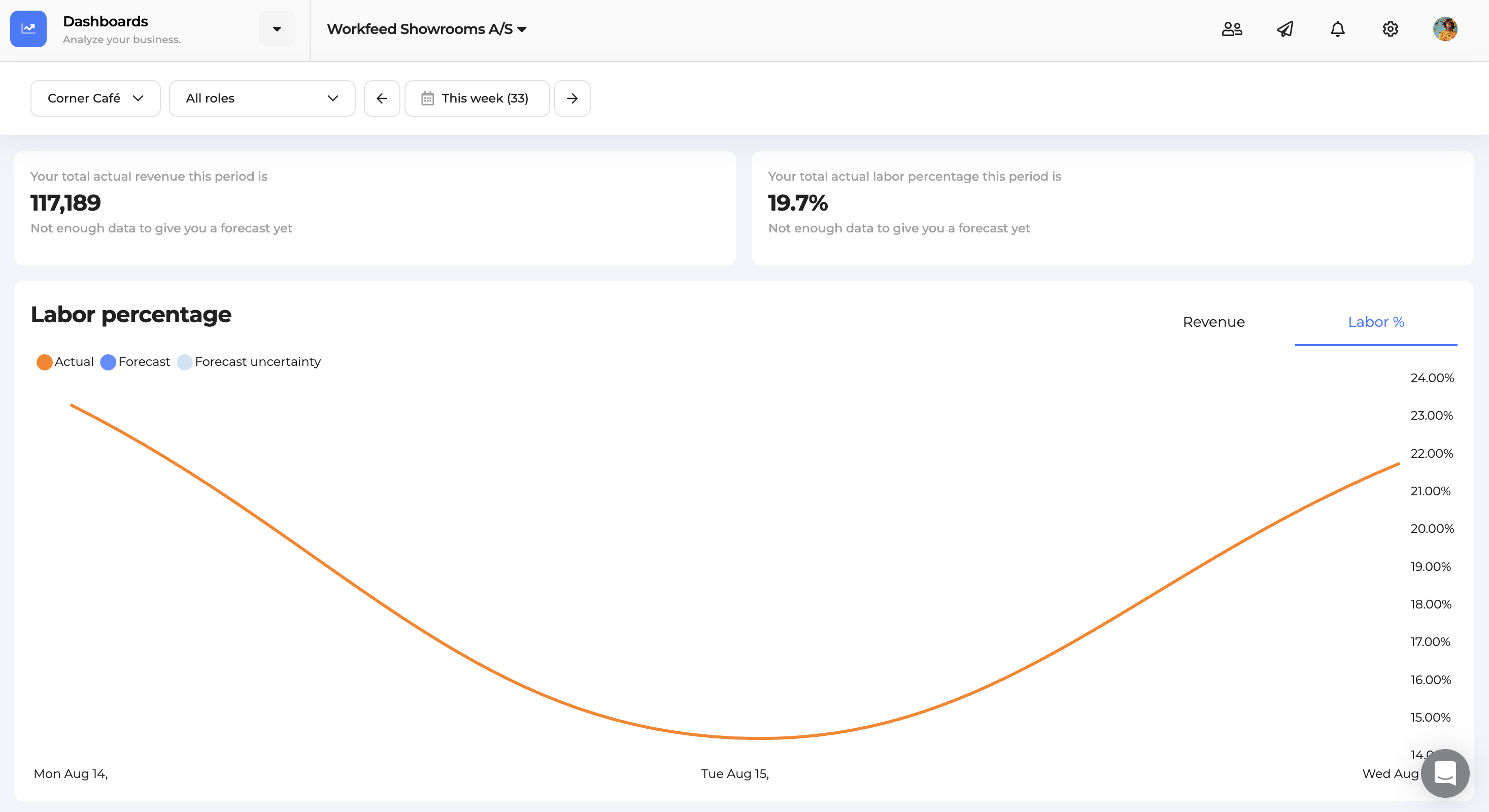
A restaurant's labor cost percentage indicates how much money a restaurant spends to pay its staff compared to the revenue it generates. Knowing your labor cost percentage is important because it can help with business decisions and ensure greater profitability.
Restaurant labor costs, or in other words, the total amount of money a restaurant spends on its employees. This includes everything from wages to benefits, and training expenses.
Managing labor costs properly is crucial to the success of any restaurant business because labor costs typically account for one of the most significant expenses. When labor costs are too high, it can negatively impact restaurant profitability.
Labor costs can impact restaurant profitability in several ways. When labor costs are too high, it can lead to lower profit margins. This is because labor costs are a fixed expense, and when they increase, the restaurant must either increase its prices or reduce its profit margins. Both of these options can negatively impact the restaurant's profitability.
On the other hand, when restaurant labor costs are too low, it can impact the quality of service provided to customers. This can lead to lower customer satisfaction, which can negatively impact the restaurant's reputation and profitability. Additionally, low labor costs can lead to high staff turnover, as employees may feel undervalued or overworked and seek employment elsewhere.
One of the most significant factors is the minimum wage in the country or state where the restaurant is located. Minimum wage laws vary from country to country and state to state. This can impact labor costs significantly, particularly for restaurants located in places with higher minimum wages.
Furthermore, the type of restaurant can also impact labor costs. For example, a fine-dining restaurant may require more highly skilled employees, which naturally increases the restaurant labor costs. The cost of living in the area can also impact labor costs, as employees in high-cost-of-living areas may require higher wages to make ends meet.
Finally, the availability of qualified workers can impact labor costs, particularly in areas with low unemployment rates.
There are several ways to achieve a better labor cost rate. One of these ways is to optimize employee schedules. By scheduling employees based on demand, restaurants can ensure that they have enough staff to provide quality service without overstaffing.
Another option is investing in employee training. Well-trained employees are typically more efficient, which can reduce labor costs. Additionally, investing in employee training can improve employee morale, which can reduce turnover and the associated costs.
Workfeed, an employee scheduling system designed for restaurants, allows you to significantly reduce the labor costs of your restaurant with minimum effort. By providing you with access to relevant data such as revenue predictions, table booking data, and weather forecast, you can make a good indication of the required staff on any given day.
The data mentioned above is showcased in the schedule overview of Workfeed, allowing you to take it into account while creating the work schedule. Once you created the schedule, your labor costs and labor cost percentage are automatically calculated by Workfeed and presented underneath the schedule.
Workfeed's dashboard view also provides you with an overview of your labor costs and labor cost percentage over a period of your choice - making it easier to maintain control over the labor costs of your restaurant.

Labor costs can include several components, including wages, employee benefits, payroll taxes, and training and development expenses. Understanding these components will help you manage your labor costs more effectively.
Calculating your labor cost percentage is fairly straightforward. The following four steps show how it works:
The first step is to determine the total amount spent on labor costs. It is essential to include all costs related to your employees in this calculation. For instance, if you provide health insurance or paid time off to your employees, you need to include those costs in your calculation.
The next step is to calculate the total revenue generated by your restaurant during the same period as the labor cost calculation. Include all sales, such as food and beverage sales, catering sales, and other revenue streams. You can use your restaurant's point-of-sale (POS) system to get an accurate picture of your revenue.
It is important to calculate the revenue for the same period as the labor cost calculation. For instance, if you are calculating labor costs for a month, you should use the revenue generated during that same month.
Divide the total labor costs by the total revenue to determine your labor cost percentage. For example, if your total labor costs are $50,000, and your total revenue is $150,000, your labor cost percentage would be 33.33% ($50,000 / $150,000).
Once you have calculated your labor cost percentage, you can compare it to industry benchmarks or your own previous records to see if any adjustments need to be made. Analyze the results and make a plan to manage future labor costs based on your findings.
You can also use labor cost percentage to identify areas where you can improve efficiency and reduce costs. For instance, if you have a high labor cost percentage, you may need to look at ways to streamline your operations, such as reducing employee hours or increasing productivity.

Industry benchmarks for labor cost percentage can help restaurant owners determine if they are spending too much or too little on labor costs. One way to compare your results to industry standards is to use the National Restaurant Association's industry ratios, which suggest that labor costs should not exceed 30-35% of total sales. However, it's important to note that this benchmark can vary depending on the size, location, and type of restaurant.
By comparing your labor cost percentage to industry standards, you can get a better idea of whether you are overspending or underspending on labor costs.
If your percentage is higher than the industry standard, it may indicate that you need to make adjustments to reduce labor costs. This could include reducing staff hours, cross-training employees to perform multiple tasks, or implementing technology to streamline operations.
On the other hand, if your percentage is lower than the industry standard, you may need to invest more in your employees to improve productivity and overall restaurant operations. This could include offering more training opportunities, providing better benefits, or increasing employee wages.
Several factors can impact labor cost percentage benchmarks. For example, a fine dining restaurant may have higher labor costs than a fast-food restaurant because of the higher level of service and the demand for skilled workers. Additionally, a restaurant located in a high cost of living area may have higher labor costs because of higher wages and salaries in the region.
Other factors that can impact labor cost percentage benchmarks include the type of cuisine served, the size of the restaurant, and the level of technology used. For example, a restaurant that serves complex dishes may require more skilled labor, which can increase labor costs. A larger restaurant may require more staff to maintain operations, which can also impact labor costs. Finally, restaurants that implement technology to streamline operations may see a reduction in labor costs over time.

There are several ways to reduce, or rather optimize, your restaurant's labor costs. What works best depends entirely on the current state of your business. Here are a few areas you should be monitoring regularly.
Consistently looking at your labor reports will give you more insight into where you may be wasting resources. No restaurant is perfect. And identifying instances where you have over-scheduled staff or inaccurate shifts can reveal where improvement can be made. Use sales data from your POS to identify services and employees where labor costs are higher than average.
It is equally important to forecast your employee schedule based on demand where possible. We all know that big holidays and major events require more staff. But you can also take a more detailed approach. Even the smallest changes in shifts can have a big impact over time, and your own data is your best friend.
It might sound obvious, but in many cases, this is a gold mine. There are several pieces of data you can use to get a good idea of the expected crowds on any given day. Data like reservations is widely used and is very effective. However, weather forecasts and historical sales data can also provide you with good insights. By properly forecasting the guests in your restaurant, you can create an appropriate schedule that avoids over and under-staffing.
But, collecting and analyzing this data is not easy. It can be time-consuming and challenging. However, it is well worth it because whenever you can predict periods of changing labor needs, you set yourself up for lower labor costs.
Ideally, your WFM/employee scheduling system provides the ability to collect this data from your other systems for you.


Reducing your labor percentage is more than ‘optimized scheduling' and having less 'unnecessary' staff on the floor. It is just as important to train and empower your employees to do their best work. If you support your employees, they will perform better, work more efficiently, be more satisfied, and ultimately generate more income. This has a positive impact on various facets of your business, including the labor percentage.
Eliminating overtime completely may be an illusion, as anything can happen. But minimizing overtime is a smart way to reduce your labor costs. Not only are there many laws that require employees to be paid 1.5x for working over 40 hours a week, but it's also not great for the well-being of your team.
Using an employee scheduling tool that can help you with forecasting makes avoiding overtime situations a lot easier. For example, Workfeed's automatic scheduling feature lets you create schedules automatically while taking into account your team's maximum working hours. It is also possible to make a good estimation of the required staff per day by using POS, table booking, and weather data. This way you can avoid over-scheduling and also ensure that your schedule is almost always accurate.


Calculating your restaurant labor cost is of great importance when it comes to improving overall restaurant profitability. Knowing the components of labor costs and benchmarking labor costs against industry standards can help you make informed decisions about managing your restaurant's labor costs. By tracking labor costs and optimizing whenever necessary, you can help ensure your restaurant business's success and longevity.

Copyright © 2024 Workfeed ApS